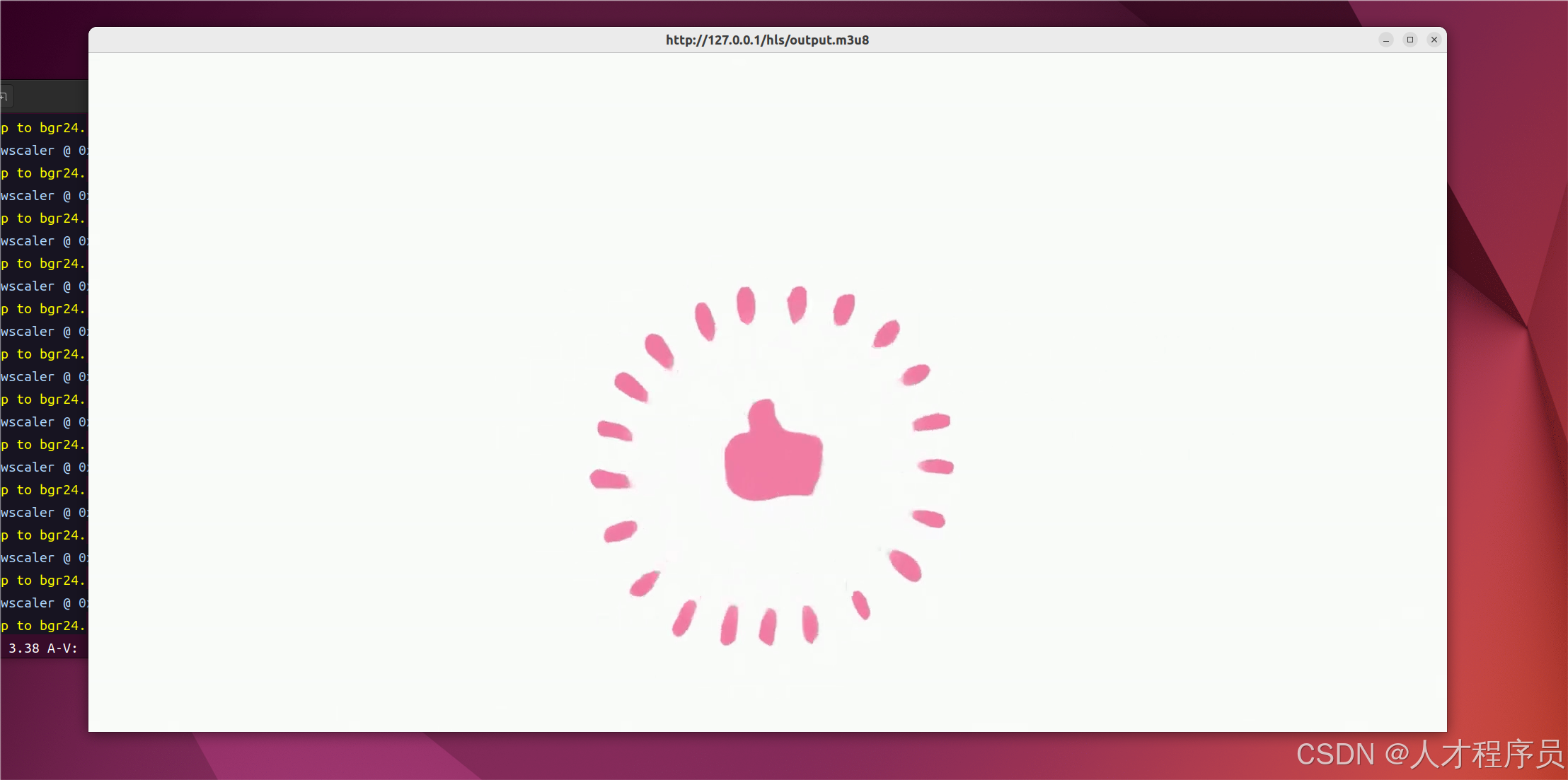文章目录
前言
在数字内容传输和流媒体服务中,HLS(HTTP Live Streaming)已经成为一种流行的解决方案,特别是在视频直播和点播应用中。要实现高效的HLS流媒体服务,Nginx作为一个高性能的Web服务器和反向代理服务器,提供了强大的支持。通过安装和配置Nginx,可以轻松创建一个功能强大的HLS流媒体服务器。本文将介绍Nginx的基础知识以及如何通过它来搭建HLS流媒体服务器。
Nginx简介
Nginx是一个高性能的Web服务器和反向代理服务器,由Igor Sysoev于2002年开发。它以高效、稳定、灵活和低内存消耗著称,适用于处理大量并发连接。Nginx不仅可以作为HTTP服务器,还可以用于负载均衡、反向代理以及作为流媒体服务器。
因为我们的HLS服务器是HTTP协议的,所以我们需要使用Nginx
Ubuntu安装Nginx
打开终端输入下面的命令即可安装Nginx:
sudo apt install nginx ffmpeg生成HLS流媒体
FFmpeg是一个强大的多媒体处理工具,它不仅能够转换、录制和流式传输多种格式的音视频,还可以生成HLS流媒体。以下是如何使用FFmpeg配置HLS流媒体,并使用FFplay播放的步骤。
1. 生成HLS流媒体
要生成HLS流媒体,需要使用FFmpeg将视频文件转换为HLS格式。HLS格式包括一个或多个 .m3u8 播放列表文件和一系列 .ts 分段文件。下面是一个基本的FFmpeg命令,用于将视频文件转换为HLS格式:
ffmpeg -i a.mp4 -codec:v libx264 -codec:a aac -b:v 1500k -b:a 128k -hls_time 10 -hls_list_size 0 -hls_segment_filename 'stream_%03d.ts' -hls_flags delete_segments output.m3u8 命令说明
-i input.mp4:指定输入视频文件。-codec:v libx264:使用H.264视频编码器。-codec:a aac:使用AAC音频编码器。-b:v 1500k:设置视频比特率为1500kbps。-b:a 128k:设置音频比特率为128kbps。-hls_time 10:每个HLS分段文件的时长为10秒。-hls_list_size 0:设置HLS播放列表大小为0,表示不限制播放列表中条目的数量。-hls_segment_filename 'stream_%03d.ts':指定HLS分段文件的名称模式。-hls_flags delete_segments:在播放列表中删除旧的HLS分段文件。output.m3u8:指定输出的HLS播放列表文件名。
运行上述命令后,你会得到一个 output.m3u8 文件和若干个 .ts 分段文件。这些文件可以用于HLS流媒体播放。
配置Nginx
使用下面的命令打开nginx.conf:
sudo nano /etc/nginx/nginx.conf 把这个搞进去:
user www-data; worker_processes auto; pid /run/nginx.pid; include /etc/nginx/modules-enabled/*.conf; events { worker_connections 768; # multi_accept on; } http { ## # Basic Settings ## sendfile on; tcp_nopush on; types_hash_max_size 2048; # server_tokens off; # server_names_hash_bucket_size 64; # server_name_in_redirect off; include /etc/nginx/mime.types; default_type application/octet-stream; ## # SSL Settings ## ssl_protocols TLSv1 TLSv1.1 TLSv1.2 TLSv1.3; # Dropping SSLv3, ref: POODLE ssl_prefer_server_ciphers on; ## # Logging Settings ## access_log /var/log/nginx/access.log; error_log /var/log/nginx/error.log; ## # Gzip Settings ## gzip on; # gzip_vary on; # gzip_proxied any; # gzip_comp_level 6; # gzip_buffers 16 8k; # gzip_http_version 1.1; # gzip_types text/plain text/css application/json application/javascript text/xml application/xml application/xml+rss text/javascript; ## # Virtual Host Configs ## include /etc/nginx/conf.d/*.conf; include /etc/nginx/sites-enabled/*; } #mail { # # See sample authentication script at: # # http://wiki.nginx.org/ImapAuthenticateWithApachePhpScript # # # auth_http localhost/auth.php; # # pop3_capabilities "TOP" "USER"; # # imap_capabilities "IMAP4rev1" "UIDPLUS"; # # server { # listen localhost:110; # protocol pop3; # proxy on; # } # # server { # listen localhost:143; # protocol imap; # proxy on; # } #} 然后使用命令打开下面这个文件:sudo nano /etc/nginx/sites-available/default
## # You should look at the following URL's in order to grasp a solid understanding # of Nginx configuration files in order to fully unleash the power of Nginx. # https://www.nginx.com/resources/wiki/start/ # https://www.nginx.com/resources/wiki/start/topics/tutorials/config_pitfalls/ # https://wiki.debian.org/Nginx/DirectoryStructure # # In most cases, administrators will remove this file from sites-enabled/ and # leave it as reference inside of sites-available where it will continue to be # updated by the nginx packaging team. # # This file will automatically load configuration files provided by other # applications, such as Drupal or Wordpress. These applications will be made # available underneath a path with that package name, such as /drupal8. # # Please see /usr/share/doc/nginx-doc/examples/ for more detailed examples. ## # Default server configuration server { listen 80 default_server; listen [::]:80 default_server; # SSL configuration # # listen 443 ssl default_server; # listen [::]:443 ssl default_server; # # Note: You should disable gzip for SSL traffic. # See: https://bugs.debian.org/773332 # # Read up on ssl_ciphers to ensure a secure configuration. # See: https://bugs.debian.org/765782 # # Self signed certs generated by the ssl-cert package # Don't use them in a production server! # # include snippets/snakeoil.conf; root /var/www/html; # Add index.php to the list if you are using PHP index index.html index.htm index.nginx-debian.html; server_name _; location / { # First attempt to serve request as file, then # as directory, then fall back to displaying a 404. try_files $uri $uri/ =404; } # pass PHP scripts to FastCGI server # #location ~ \.php$ { # include snippets/fastcgi-php.conf; # # # With php-fpm (or other unix sockets): # fastcgi_pass unix:/run/php/php7.4-fpm.sock; # # With php-cgi (or other tcp sockets): # fastcgi_pass 127.0.0.1:9000; #} } # HLS server configuration server { listen 80; server_name localhost; location /hls/ { types { application/vnd.apple.mpegurl m3u8; video/mp2t ts; } alias /var/www/html/hls/; add_header Cache-Control no-cache; add_header Access-Control-Allow-Origin *; } location / { root /var/www/html; index index.html index.htm; } } 紧接着,我们需要把我们生成的ts和m3u8文件复制到/var/www/html/hls/这个路径下面:
ubuntu@ubuntu-virtual-machine:~/HLS$ ls /var/www/html/hls/ output.m3u8 stream_000.ts stream_001.ts stream_002.ts stream_003.ts 最后我们测试他即可:
sudo nginx -t 如果成功则:
sudo systemctl reload nginx 然后我们还需要确保文件的权限:
sudo chown -R www-data:www-data /var/www/html/hls/ sudo chmod -R 755 /var/www/html/hls/ ffplay播放m3u8
我们使用本ubuntu的ffplay播放:
ffplay http://127.0.0.1/hls/output.m3u8 
总结
通过Nginx配置HLS流媒体服务器,不仅能够提供高效的流媒体服务,还能够利用Nginx的高性能特性,处理大量并发请求。Nginx的灵活配置和强大功能使其成为流媒体应用的理想选择。本文介绍了Nginx的基本信息、安装过程及HLS配置,希望能为你的流媒体服务搭建提供帮助。
